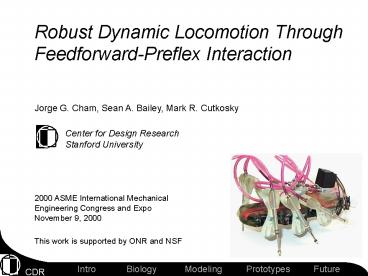Robust Dynamic Locomotion Through PowerPoint PPT Presentation
Title: Robust Dynamic Locomotion Through
1
Robust Dynamic Locomotion Through
Feedforward-Preflex Interaction
Jorge G. Cham, Sean A. Bailey, Mark R. Cutkosky
Center for Design Research Stanford University
2000 ASME International Mechanical Engineering
Congress and Expo November 9, 2000
This work is supported by ONR and NSF
2
Robust Dynamic Locomotion
Background and Motivation
Biological Inspiration
Modeling Approach
Hexapedal Prototypes
Conclusions And Future Work
Biology
Prototypes
Modeling
3
Motivation
- Hazardous tasks for humans
- Access to areas inaccessible to wheeled vehicles
- Legged animals are faster and more agile in rough
terrain
Intro
4
Motivation
- Most current robots have neither simplicity of
wheels - nor versatility and speed of legged animals
Dante Robot
Raibert Monopod
Intro
5
Motivation
- Statically-stable robots
- Robust by maintaining at least three legs on the
ground - Limited speed
Dante Robot
Raibert Monopod
Intro
6
Motivation
- Dynamically-stable robots
- Fast locomotion that is stable over time
- Limited robustness and versatility
Dante Robot
Raibert Monopod
Intro
7
Motivation
- Robust and Dynamic
- Robustness Rapid convergence to desirable
behavior steady-state despite large disturbances - Dynamic significant transfers of kinetic and
potential energies
Deathhead Cockroach
Intro
8
Recent Work
- Passively-stable walking (McGeer, 1990)
- Self-stabilizing running (Ringrose, 1997)
- Rhex (Saranli, 2000)
Intro
9
Hypothesis
- Robust and Dynamic locomotion can be achieved
with no sensory feedback - Disturbance-rejection is a property of the
mechanical system - tuned to a feedforward (open loop) activation
Intro
10
Biological Inspiration
- Up to 50 body-lengths per second
- Traverse terrain with obstacle three times height
of center of mass - Prof. Robert Full, Berkeley Polypedal Lab
Biology
11
Biological Inspiration
- When transitioning from flat to rough terrain
- impulses sent to the muscles did not noticeably
change - Similar activation despite large changes in
events
Flat terrain
Rough terrain
Biology
12
Biological Inspiration
- Implies exclusion of sensory feedback
- No precise foot-placement or follow-the-leader
gait - But still able to traverse rough terrain..!
Biology
13
Preflexes
- Passive properties of the mechanical system
- that stabilize and reject disturbances
- Immediate response
- No delays associated with sense-compute-command
loops
Biology
14
Preflexes Self-Stabilizing Posture
- Sprawled posture
- Individual leg function
- Front legs decelerate, hind legs accelerate
- Self-correcting forces with respect to the
geometry
Biology
15
Preflexes Visco-elastic Properties
- Exoskeleton and muscle properties
- Compliance
- Damping
Biology
16
Control Hierarchy
Neural System (CPG)
- Preflexes provide immediate stabilization for
repetitive task - Reflexes and neural feedback adapt to changing
conditions - through the feedforward pattern
Feedforward Motor Pattern
Sensory Feedback (Reflexes)
Mechanical System (muscles, limbs)
Mechanical Feedback (Preflexes)
Environment
Passive Dynamic Self-Stabilization
Locomotion
Biology
17
Modeling
- Initial attempts at characterizing stability and
performance - of a feedforward activation pattern
- applied to a properly designed passive
mechanical system
Modeling
18
Modeling - Mode Transitions
- Locomotion is a series of transitions between
modes - Here, modes are determined by the feedforward
pattern - especially if we dont account for a flight phase
Modeling
19
Modeling Linear systems
- Show that feedforward mode transitions
- result in stable, converging periodic motion
Modeling
20
Modeling Non-linear 2 DOF
Servo
- Simple model
- Opposing legs with passive properties
- At fixed times, legs are given an impulse
extension
Sagittal plane
k, b, ?nom
Planar Quadruped simplified model
Modeling
21
Modeling Non-linear 2 DOF
- At beginning of mode
Modeling
22
Modeling Non-linear 2 DOF
- At beginning of mode
- the mass moves
Modeling
23
Modeling Non-linear 2 DOF
- At beginning of mode
- the mass moves
- according to the modes dynamics
Modeling
24
Modeling Non-linear 2 DOF
- At a fixed time
Modeling
25
Modeling Non-linear 2 DOF
- At a fixed time
- the system transitions to the new mode
- carrying the state conditions into the next mode
Modeling
26
Modeling Non-linear 2 DOF
- Simulations show that for a wide range of system
parameters - trajectories converge to stable periodic motion
- despite large disturbances
Modeling
27
Modeling Floquet Analysis
- Behavior is confirmed by Floquet analysis
- Small perturbation analysis
- Floquet multipliers indicate attractiveness of
periodic motion
Modeling
28
Modeling System Behavior
- Chasing an equilibrium
- Equilibrium changes at fixed times according to
activation pattern - System parameters influence trajectory within mode
Modeling
29
Prototypes
- Built prototypes based on biological principles
described - No active sensing
- Fixed cycle of tripod activation
time
Feedforward Activation Pattern
Prototypes
30
Prototype - Design
- Sprawled Posture
- Leg function
- Compliant joints
Prototypes
31
Prototype - Design
- Passive compliant hip joint in sagittal plane
- Piston thrusts along direction of hip
Prototypes
32
Prototype - Fabrication
- Fabrication for robustness
- Active components embedded inside structure
- Integrated soft-hard materials in joints
Cycle of Integrated Fabrication of Robot
Prototypes
33
Prototype - Performance
- Dynamic running
- Speeds of up to 3 body-lengths per second (40
cm/sec)
Prototypes
34
Prototype - Performance
- Obstacles of hip-height
- Slopes of up to 18 deg.
Prototypes
35
Prototype - Movie
gtOgt
Prototypes
36
Conclusions
- Findings from biomechanics suggests that robust
dynamic locomotion - can be achieved without sensory feedback
- Prototypes and simulations confirm fast, stable
performance
Future
37
Future Work
- Characterize role of system properties
- to design for appropriate performance
- Using higher level feedback (reflexes) for
adaptation
Future
38
Questions?Acknowledgements
- ONR, NSF
- Jonathan Clark, Pratik Nahata, Ed Froehlich
- Stanford DML and RPL
Intro
Biology
Prototypes
Modeling
Future

